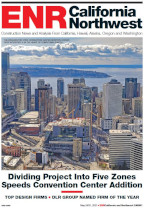 |
| HERE TO STAY New type of temporary bridge can last up to 30 years, officials maintain. |
A rural state route in northwestern Massachusetts is the site of the first U.S. launch of a prefabricated panel bridge that uses bolts instead of pins. Officials say the cost-saving method may help state transportation departments ease the need for permanent structures.
"It's not our biggest bridge, but it is good-sized," says Kevin Traynor, sales representative for Mabey Bridge & Shore Inc., Elkridge, Md. The firm literally rolled out its "delta" bridge on State Route 112N this month over the North River in Colrain. The 236-ft-long truss panel bridge has a 24-ft-wide roadway and a cantilevered 5-ft-wide walkway. The bridge is load-rated HS 20, meaning it can support standard highway vehicles.
Crews launched the cantilevered rails on rollers and used a temporary, lightweight nose to clear the gap. "It's [prefabricated], modular, launchable and can be configured in any length up to 260 ft long and four lanes wide," says Mabey's Traynor. The bridge will open July 4.
Pittsfield, Mass.-based Petricca Construction Co. installed the bridge as part of a $2.6-million contract to replace an existing 65-year-old, two-lane steel bridge with a precast concrete box girder bridge. The state had planned a temporary two-span traditional panel type bridge with a center pier, but Petricca and Mabey suggested the Delta bridge.
 |
 |
| DELTA BRIDGE Bolts join span segments. |
It took a month to assemble and erect, says Terry R. Seymour, Petricca project manager. "The bridge arrived in 22 trucks, and we were able to set up a 50-ft-wide, 200-ft-long laydown area in line with the gap." Assembling pin bridges is easier but they "are noisier and they bounce around and sag," says Seymour. "This bridge still has two inches of positive camber before the asphalt is laid." Petricca is renting the bridge for 26 months at a promotional cost of about $163,000.
The year-old Delta bridge has been used in the Philippines. Mabey is promoting the design, with its 30-year lifespan, as a permanent option on secondary roads. Seymour claims that if it were used in Colrain instead of building a replacement "it could have been done for a third of the cost." Notes Alexander K. Bardow, state highway department bridge engineer, "We're willing to consider permanent applications as long as it meets [standard] specs and any fracture-critical design requirements."
(Photos courtesy of Mabey Bridge & Shore Inc.)




Post a comment to this article
Report Abusive Comment